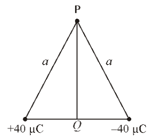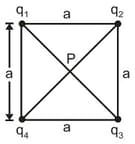Potential due to System of Charges
Potential due to System of Charges: Overview
This Topic covers sub-topics such as Electric Potential due to Two or More Charges at a Point
Important Questions on Potential due to System of Charges
Three charges and respectively are placed on the vertices of an equilateral triangle of side. Calculate the electric potential at the centre of the triangle.
Four charges each is placed on four corners of a square of side . Find the potential at the centre of square.
A charge of is placed on each of the vertices of a regular hexagon of side , Find the electric potential at the centre of hexagon.
Two point charges, and are apart. At what points on the line joining the charges the electric potential is zero? Assume the electric potential to be zero at infinity.
Four charges, and respectively are placed on four corners of a square of edge . Find the electric potential at the centre of square.
For the arrangement of charges as shown in adjoining diagram, the work done in moving a charge from to (in joule) is

Cotyledons are also called-
Assertion: When two charges are brought close to each other, potential energy of the system may increase or decrease.
Reason: When work done by a conservative force is positive, the potential energy of the system increases, and when work done by a conservative force is negative, the potential energy of the system decreases.
Assertion: The work done by a non-uniform electric field on a charged particle starting from rest may be zero. (Assume no other forces act on the charged particle).
Reason: The angle between electrostatic force and velocity of the charged particle released from rest in non-uniform electric field is always acute. (Assume no other forces act on the charged particle.)
Eight charges, each of magnitude are placed at the vertices of a cube placed in vacuum. Electric potential at the centre of the cube due to this system of charges is:
( is permittivity of vacuum and is length of each side of the cube)
A charge is fixed at each of the points upto , on -axis, and charge is fixed at each of the points upto . Here, is a positive constant. Take the potential at a point, due to a charge at a distance from it, to be . Then, the potential at the origin, due to the above system of charges, will be
An electric charge is placed at the origin . Two points and are situated at and respectively. The potential difference between the points and will be
The potential at a point which is a corner of a square of the side with charges, , located at the other three corners is nearly
is a rectangle. At corners , and of the rectangle are placed charges , and , respectively. Calculate the potential at the fourth corner. (The side and )
is a rectangle. At corners and of the rectangle are placed charges , and , respectively. Calculate the potential at the fourth corner.
(The side, and )
Positive and negative point charges of equal magnitude are kept at
respectively. The work done by the electric field when another positive point charge is moved from is
Two point charges and are apart as shown in the figure. Find the potential difference between the points and .

Four-point charge and are placed at the corners of the squares of side , as shown in the figure. Calculate the potential at the centre of the square.

(Given: , , , and .)
Two charges and are kept apart. Then, at any point on the right bisector of line joining the two charges,
Two point charges and are located at points and , respectively. The electric potential at a point , where, is:
